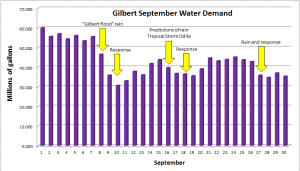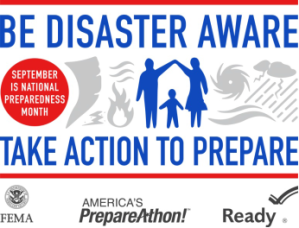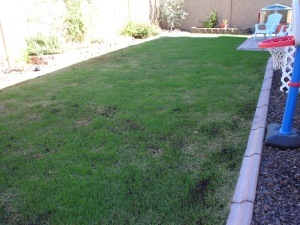 During the month of September, with all those rains, you took notice! Our water production data indicates that Gilbert residents and businesses did an amazing job of responding to the rainfall by reducing outdoor water use.
During the month of September, with all those rains, you took notice! Our water production data indicates that Gilbert residents and businesses did an amazing job of responding to the rainfall by reducing outdoor water use.
It’s rare in the world of water conservation to see drastic decreases in water use in a short amount of time. We’ve seen a steady decrease in household water use over the years, with the implementation of new indoor technology such as water efficient toilets, showerheads, and clothes washers. However, to see real-time water conservation responses is a rare treat indeed.
After the September 7th and 8th flooding rain event, you responded by reducing your total water consumption by 20 million gallons… a day. You kept those controllers off too, and the savings persisted for about a week.
Then, with all the predictions that Hurricane Odile was going to drop another whopper on us, you anticipated the rain and proactively shut your controllers off. Production dropped from an average of 42 million gallons a day the few days preceding the storm, to an average of 37 million gallons a day—a savings of about 5 million gallons of water a day. Even though that storm didn’t deliver the anticipated rainfall, a lot of you figured you could keep those controllers off given the cloudiness and moisture that remained in your soil from the previous storm.
The final story in this water production data picture is that when it rained again on September 27th, you overwhelmingly responded. Water production dropped even lower, from an average of 43 million gallons a day preceding that rain event to an average of 35 million gallons per day. Another bulk water savings, this time of 8 million gallons of water a day.
In total, all that amounts to a cumulative water savings of 239,052,000 gallons for the month of September, or an 18 percent drop in water demand from last September.
 This is a testament to your keen eye on conservation. You care. It matters. We can continue to improve on this trend by doing things such as adjusting our controllers monthly, checking for leaks inside and outside the home, and paying attention to how much water we should be putting out on the landscape.
This is a testament to your keen eye on conservation. You care. It matters. We can continue to improve on this trend by doing things such as adjusting our controllers monthly, checking for leaks inside and outside the home, and paying attention to how much water we should be putting out on the landscape.
All of your individual actions add up to collective water savings.
The majority of water use is outdoors. That’s why we focus on it so much here in the monthly blogs. If you are bamboozled by your watering system, give us a call (480-503-6098) or email and we can set up a time to go through your system with you and offer you tips for savings.
If you ever want to see how much rain fell near your house, visit rainlog.org. If 0.5 or more inches of rain fell near you, that’s your cue to turn off the controller. When you can no longer easily stick a long screwdriver 8 inches into the soil, that’s when you will want to turn your controller back on.
Thanks for helping to do your part to save water here in Gilbert!
 As part of a continuing effort to become Gilbert’s number one source for Gilbert news, we are moving all future blog content to our redesigned website. For all things Gilbert, simply visit gilbertaz.gov/news to see all of the latest information, photos, videos and updates in the Digital Newsroom.
As part of a continuing effort to become Gilbert’s number one source for Gilbert news, we are moving all future blog content to our redesigned website. For all things Gilbert, simply visit gilbertaz.gov/news to see all of the latest information, photos, videos and updates in the Digital Newsroom.




